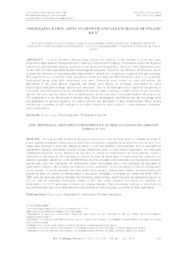Trinexapac-ethyl affects growth and gas exchange of upland rice.
Trinexapac-ethyl affects growth and gas exchange of upland rice.
Author(s): ALVAREZ, R. de C. F.; CRUSCIOL, C. A. C.; NASCENTE, A. S.; RODRIGUES, J. D.; HABERMANN, G.; PAIVA NETO, V. B. de
Summary: A major problem affecting some upland rice cultivars is the increase in plant size when subjected to high doses of nitrogen fertilizer, leading to high levels of lodging. A method to reduce the height of upland rice, and therefore lodging, would be to use plant growth regulators. However, little information exists on the effect of these regulators on plant physiological processes. Therefore, the objective of this study was to evaluate the influence of trinexapac-ethyl application in upland rice via analysis of growth and gas exchange. The experiment was carried out under greenhouse conditions using the BRS Primavera cultivar. A completely randomized design with eight replications was used. Treatments were carried out with and without the application of the plant growth regulator, and plants were subject to two-stage assessments in which physiological and gas-exchange indices were measured. The use of trinexapac-ethyl improved the growth of rice plants from the flowering to the physiological maturity stage, resulting in higher values of leaf area ratio, specific leaf area, and leaf matter ratio in treated plants. At the same time, it provided smaller reduction in net CO2 assimilation at the physiological maturity stage. Thus, net/apparent assimilation rate did not change after the application of growth regulator, but relative growth rate decreased in these treated plants. These results indicate the occurrence of self-shading in rice plants induced by what might be a supra-optimum trinexapac-ethyl concentration.
Publication year: 2016
Types of publication: Journal article
Unit: Embrapa Rice & Beans
Observation
Some of Embrapa's publications are published as ePub files. To read them, use or download one of the following free software options to your computer or mobile device. Android: Google Play Books; IOS: iBooks; Windows and Linux: Calibre.
Access other publications
Access the Agricultural Research Database (BDPA) to consult Embrapa's full library collection and records.
Visit Embrapa Bookstore to purchase books and other publications sold by Embrapa.

